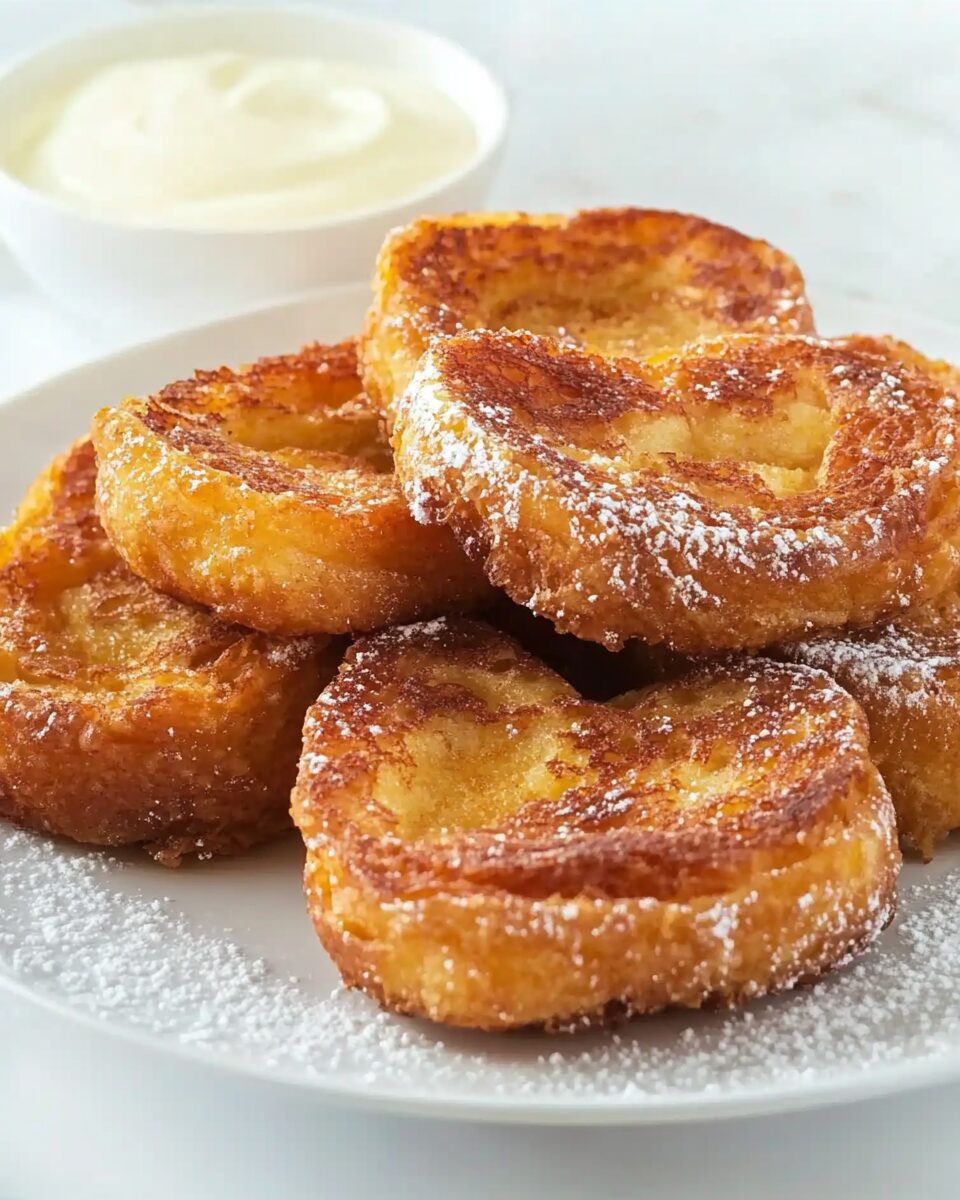The beloved Torrijas is a treasured dessert or breakfast dish across Spain, especially during Holy Week. Similar to French toast but uniquely Spanish in preparation, this cozy treat is made by soaking slices of crusty bread in milk infused with cinnamon and lemon zest, then dipping them in egg and frying them to a crisp golden brown. Finally, they’re coated in cinnamon sugar for the perfect sweet touch.
Whether served warm with a drizzle of honey or enjoyed at room temperature with coffee or tea, Torrijas are simple yet deeply satisfying. It’s the kind of recipe that brings comfort and nostalgia to the table, making it a cherished dish passed down through generations.
Full Recipe
Ingredients:
-
1 baguette (or similar crusty bread), cut into 1-inch thick slices
-
2 cups whole milk
-
1 cinnamon stick
-
Peel of 1 lemon
-
3 tablespoons sugar
-
2 eggs
-
Olive oil, for frying
-
1/4 cup sugar (for coating)
-
1 tablespoon ground cinnamon
-
Honey (optional, for drizzling)
Directions:
-
In a saucepan, combine the milk, cinnamon stick, lemon peel, and 3 tablespoons of sugar. Heat over medium heat until just before boiling. Remove from heat and let steep until it cools slightly. Strain to remove solids.
-
Lay the bread slices in a single layer in a large dish. Pour the warm milk mixture over the bread and let soak for about 10–15 minutes until the bread is saturated but not falling apart.
-
In a separate bowl, beat the eggs.
-
Carefully lift each soaked bread slice and dip it into the beaten eggs, coating both sides.
-
Heat olive oil in a large frying pan over medium-high heat.
-
Fry the slices in batches, about 2–3 minutes per side, until golden brown. Place on a paper towel-lined plate to drain excess oil.
-
In a shallow dish, mix 1/4 cup sugar with ground cinnamon. Coat the warm torrijas in the cinnamon sugar mixture.
-
Serve warm or at room temperature. Drizzle with honey if desired.
Prep Time: 15 minutes | Cooking Time: 20 minutes | Total Time: 35 minutes
Kcal: 290 kcal | Servings: 6 slices
What Are Torrijas?
Torrijas are a beloved traditional Spanish dish, most often enjoyed during Semana Santa (Holy Week), although they are cherished year-round by those who appreciate comforting, home-cooked desserts. At their core, torrijas are similar to French toast but with a distinctly Spanish twist in both flavor and preparation. They consist of thick slices of slightly stale bread soaked in milk infused with cinnamon and lemon zest, then dipped in egg, fried until golden, and finally coated with sugar and cinnamon or drizzled with honey.
This delightful treat has been a part of Spanish culinary heritage for centuries. Its origins date back to at least the 15th century, and it was historically associated with making use of leftover bread, avoiding waste, and creating something sweet and satisfying from simple ingredients.
Cultural Significance of Torrijas
In Spain, torrijas carry emotional and cultural weight. They are more than just a recipe — they are a symbol of family gatherings, Easter celebrations, and the creativity found in traditional home cooking. During Holy Week, bakeries and home kitchens across the country prepare countless variations of torrijas, often using different types of bread, sweeteners, and liquids.
Their humble ingredients reflect the frugality and ingenuity of generations past, especially in rural communities. In religious contexts, torrijas became a popular dish to prepare during Lent, a time when meat consumption is limited, and simpler, vegetarian dishes become the focus.
Why Torrijas Are Different from French Toast
Although torrijas and French toast may look similar at first glance, their textures and flavors offer noticeably different experiences. French toast typically uses fresh bread and a batter of milk and eggs combined, often with vanilla. Torrijas, on the other hand, use stale bread — which is crucial for soaking in the infused milk without falling apart — and separate the soaking and coating processes.
The milk in torrijas is usually flavored with cinnamon sticks and citrus peel (most often lemon), creating a subtly aromatic profile. Some regions of Spain even soak the bread in wine or sweet liqueur instead of milk, giving the dish an entirely new dimension. After frying, they are coated in sugar and cinnamon or bathed in syrup or honey, making each bite rich, sweet, and comforting.
The Importance of Bread Selection
Choosing the right bread is one of the most crucial elements in preparing torrijas. In Spain, a type of firm, crusty loaf specifically for torrijas is often used, but a day-old baguette, brioche, or any dense white bread will work well. The bread needs to be absorbent yet resilient enough not to crumble during the soaking and frying stages.
Ideally, the bread slices are about an inch thick, allowing them to soak up the flavored milk thoroughly while maintaining their structure when fried. This results in a custard-like center with a crispy, golden exterior.
Flavor Variations and Regional Twists
Like many traditional recipes, torrijas can vary significantly from region to region in Spain, and families often have their own secret variations passed down through generations. Some recipes call for soaking the bread in red wine instead of milk, creating a richer, deeper flavor. Others add a splash of anise liqueur or sweet dessert wine.
You can also find torrijas covered in honey syrup or sugar glaze, giving them a glossy finish and extra sweetness. In modern takes on the dish, chefs may infuse the milk with vanilla, orange zest, or even lavender, bringing a more contemporary flair to this timeless recipe.
Another popular twist is baking instead of frying the torrijas. While frying provides the authentic crisp texture, baking can be a slightly healthier alternative and still achieves a satisfying result when brushed with oil or butter.
How to Serve Torrijas
Torrijas are incredibly versatile and can be enjoyed in a variety of ways. Traditionally, they are served warm or at room temperature as a dessert, snack, or even breakfast. They pair wonderfully with a cup of coffee, hot chocolate, or tea.
For a more indulgent presentation, drizzle them with honey, caramel, or a citrusy syrup. You can also top them with whipped cream, fresh berries, or a scoop of vanilla ice cream if you’re serving them as a plated dessert. A dusting of powdered sugar adds a final elegant touch.
Because of their rich, sweet flavor, torrijas also pair well with slightly tart fruits like raspberries or slices of citrus, offering a contrast that balances the sweetness.
Storage and Make-Ahead Tips
Torrijas are best enjoyed fresh, but they can be stored for up to 2 days in the refrigerator. To reheat, place them in a low oven or rewarm in a skillet to revive their crispy texture. Avoid microwaving them, as it can make them soggy.
If you’re planning to make torrijas for a gathering or holiday meal, you can soak the bread slices in the milk ahead of time and store them in the fridge. Simply fry and coat them shortly before serving to maintain the texture.
You can also freeze the fried and cooled torrijas for up to a month. When ready to serve, reheat them in the oven until warmed through and crisp on the edges. Be sure to coat them in fresh sugar and cinnamon after reheating, as freezing can dull the sweetness.
Healthier Options for Torrijas
While traditional torrijas are fried and sugary, there are ways to make them slightly healthier without sacrificing flavor. For example, you can bake them instead of frying or use an air fryer for a crispy finish with less oil.
Using plant-based milk like almond or oat milk works well for dairy-free versions. For a refined sugar-free alternative, replace white sugar with coconut sugar or drizzle them with pure maple syrup or agave nectar. Whole-grain bread can also be used, though it will slightly alter the texture and flavor profile.
Even with these adaptations, the spirit of torrijas remains — comforting, nostalgic, and satisfying.
Why You’ll Love Torrijas
Torrijas are the kind of dish that evokes emotion with every bite. They are soft, warm, fragrant, and sweet — the perfect balance of indulgence and simplicity. Whether you’re looking for a traditional Easter treat, a cozy weekend brunch idea, or a nostalgic dessert, this recipe will not disappoint.
It’s also a wonderful way to introduce people to Spanish cuisine. Torrijas can be easily made with pantry staples, require minimal preparation, and yield an impressive result that feels both rustic and elegant.
Plus, it’s a great activity to do with kids or family members. From soaking the bread to coating it in sugar and cinnamon, it’s a fun and delicious way to bond over food and create new memories.
Conclusion
Torrijas are more than just Spain’s answer to French toast — they’re a warm slice of history, culture, and family tradition. With their soft custardy center and golden, crispy exterior, they bring joy and comfort to any table. Whether enjoyed during Holy Week or on a quiet Sunday morning, they’re the kind of treat that invites you to slow down and savor the moment.
If you’ve never made torrijas before, now is the perfect time to start. It’s a simple, soulful dish that speaks to the heart, and once you try it, you’ll understand why it’s cherished by so many. From their centuries-old roots to their modern-day variations, torrijas are a sweet tradition worth keeping alive — one delicious slice at a time.






